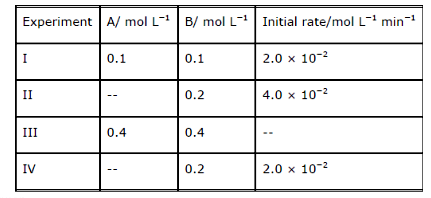If reaction between A and B to give C shows first order kinetics in A and second order in B, the rate equation can be written as
Rate = k[A][B]1/2
Rate = k[A]1/2[B]
Rate = k[A][B]2
Rate = k[A]2[B]
The correct Answer is:c
Step by step video, text & image solution for If reaction between A and B to give C shows first order kinetics in A and second order in B, the rate equation can be written as by Chemistry experts to help you in doubts & scoring excellent marks in Class 12 exams.
Updated on:21/07/2023Topper's Solved these Questions
- CHEMICAL KINETICS BOOK - ERRORLESS CHAPTER - CHEMICAL KINETICS EXERCISE - Ordinary Thinking (Collision theory , Energy of activation and Arrhenius equation )
45 Videos
- CHEMICAL KINETICS BOOK - ERRORLESS CHAPTER - CHEMICAL KINETICS EXERCISE - Critical Thinking Objective Questions
20 Videos
- CHEMICAL KINETICS BOOK - ERRORLESS CHAPTER - CHEMICAL KINETICS EXERCISE - JEE (Advanced ) 2018
1 Videos
- CHEMICAL EQULIBRIUMBOOK - ERRORLESS CHAPTER - CHEMICAL EQULIBRIUMEXERCISE - JS JEE SECTION (ONLY ONE CHOICE ANSWER (Matrix)
1 Videos
- CHEMISTRY IN EVERYDAY IN LIFEBOOK - ERRORLESS CHAPTER - CHEMISTRY IN EVERYDAY IN LIFEEXERCISE - Critical Thinking (Objective question )
25 Videos
Similar Questions
Knowledge Check
Rate equation for a second order is
AK=2.303tlogaa−xBK=1tlogaa−xCK=1tlogaa(a−x)DK=1t2logaa−x
A reaction is of first order in reactant A and of second order in reactant B. How is the rate of this reaction affected when (i) the concentration of B alone is increased to three times. (ii) the concentrations of A as well as B are doubled?
View SolutionA reaction is of first order in reactant A and of second order in reactant B. How is the rate of this reaction affected when (i) the concentration of B alone is increased to three times (ii) the concentrations of A as well as B are doubled?
View SolutionA reaction is of first order in reactant A and of second order in reactant B. How is the rate of this reaction affected when (i) the concentration of B alone is increased to three times (ii) the concentrations of A as well as B are doubled?
View SolutionA reaction is first order in A and second order in B
(i) Write the differential rate equation.
(ii) How is the rate affected on increasing the concentation of B three times ?
(iii) How is the rate affected when the concentration of both A and B are doubled ?
View SolutionThe reaction between A and B is first order with respect to A and zero order with respect to B. Fill in the blanks in the following table :

View SolutionThe reaction between A and B is first order with respect to A and zero order with respect to B. Fill in the blanks in the following table:

View SolutionThe reaction between A and B is first order with respect to A and zero order with respect to B. Fill in the blanks in the following table.

View Solution
